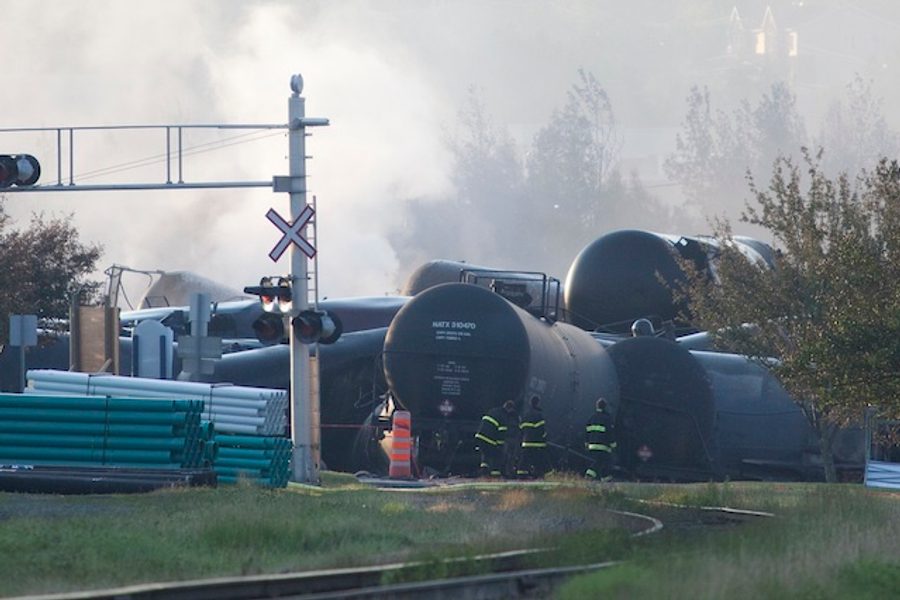
When a runaway train slammed into the small Quebec town of Lac-Megantic in July, incinerating the city’s core and killing 47 people, it may have marked the end of the line for the perilous, profit-maximizing model of railroading that has enthralled corporate and government officials across North America and the globe.
The principal proponent of this laissez-faire template for railroading — raising income while minimizing maintenance costs, resisting safety regulations, and fighting unions and adequate staffing — has been, fittingly enough, none other than Edward Burkhardt, owner of the Montreal, Maine, and Atlantic (MM&A) railway whose train decimated Lac-Megantic this summer.
Burkhardt — who also owns MM&A’s parent company, Illinois based Rail World Inc., which controls rail lines in the U.S. and Poland in addition to several hundred miles of MM&A track in Canada — was a pioneer in recognizing the profit-generating possibilities of rail deregulation made available by the Staggers Rail Act of 1980. The act permitted the formation of non-rail holding companies by rail corporations, who could then use the rationale that the rail lines had “new” owners to tear up existing union contracts.
Burkhardt was among the first to use this loophole in the Staggers Act to try to eliminate rail unions, which also facilitated reducing track maintenance and cutting rail-crew sizes to a minimum. Burkhardt has long been pressing for one-man crews and radio-directed unmanned trains.
He began actively employing this approach in the 1980s with the Wisconsin Central Railroad, ferociously resisting unionization efforts and keeping maintenance costs at a minimum. After buying up 2,700 miles of Soo Line track, Burkhardt used the newly formed Wisconsin Central Railroad to apply his model of profit maximization: fighting unionization, slashing crew size and skimping on track maintenance.
As doctrines of what might be branded “free-market fundamentalism” took root among corporate leaders and media elites in the English-speaking world, Burkhardt gained more opportunities for revenue even while his companies’ reputations suffered.
“Wisconsin Central — which also took advantage of privatization to acquire rail operations in countries such as Britain, Australia and New Zealand — racked up a questionable safety record,” noted Philip Mattera, Research Director and the Director of the Corporate Research Project at Good Jobs First.
But despite several near-disasters at Wisconsin Central, Burkhardt’s influence continued to grow. After being chosen as “Railroader of the Year” in 1999 by Railway Age magazine, his rail empire further extended globally. The World Bank, notorious for promoting and enforcing policies that elevate profits above human needs, repeatedly used him as a consultant for their pro-privatization maneuvers, eventually anointing him as the head of privatized railroads in Estonia and Poland as well as Honorary Consul for New Zealand at Chicago.
A growing danger
The social costs — both to community health and to workers’ living standards and safety — of Burkhardt’s cost-cutting model were ignored by his admirers despite dangerous accidents in the 1990s that foreshadowed the Lac-Megantic catastrophe. On March 4, 1996, a derailment of a petroleum-laden train in Weyauwega, Wis. set off a fire that blazed for two weeks and forced 3,000 residents from their homes. Only the actions of the conductor, who uncoupled the cars carrying chemicals and propane, prevented the fire from spreading even further. He was part of a two-man crew — at a time when several rail companies, including Wisconsin Central, were experimenting with cutting crew teams down to single members.
The next year, a derailment in Fond du Lac killed two workers when a Wisconsin Central freight train veered off the tracks and crashed into a factory.
According to Craig Peachy, legislative director for the Wisconsin Transportation Division of the Sheet Metal, Air, Rail & Transportation Workers Union (SMART), understaffing and poor maintenance clearly led to both crashes.
The mounting list of accidents moved even conservative Republican legislators. Wisconsin Central’s practices prompted Rep. Gov. Tommy Thompson to sign a bill in 1997 mandating two-man crews. “I think it was the only law mandating two-man crews in the nation,” Peachy told In These Times.
However, the law was eventually ruled unconstitutional by federal judges, who determined that the Interstate Commerce Act required the crew size to be standardized equally throughout all states.
Montreal, Maine, and Atlantic’s decline
Burkhardt’s 2003 purchase of MM&A, then facing financial troubles, was conducted in his typical style: by pressuring Brotherhood of Locomotive Engineers and Trainmen union members to accept pay cuts between 25 and 40 percent. Claiming that he was seeking to “improve safety and efficiency,” Burkhardt also sought in 2010 to reduce MM&A’s crew size from two workers to one.
That step led veteran engineer Jarod Briggs to quit MM&A. He told the Toronto Star, “If you have two people watching, you can catch a mistake. It was all about cutting, cutting, cutting. It’s just an example of putting company profits ahead of public safety.”
MM&A also apparently had no regular crews of its own to maintain its tracks, relying instead on contractors, SMART’s James Stem told In These Times.
These cost-cutting practices have arguably resulted in dangerous lapses in safety. According to the Toronto Globe & Mail, MM&A reported more accidents than 93% of the 288 small rail lines between 2009 and 2012. The crash at Lac-Megantic is just the latest tragedy.
Roy LaFontaine, a Lac-Megantic contractor who frequently worked for MM&A to perform maintenance work, told local reporters that the tracks should have been changed a century ago. LaFontaine, who suffered the loss of his son, two daughters-in-law, and an employee in the July explosion and fire, cited incidents like derailments and subsequent fuel spills as evidence that MM&A frequently left stretches of track without vital upkeep.
A full-scale Transportation Safety Board of Canada investigation of what caused the Lac-Megantic disaster is underway, but another failure of maintenance appears to be the culprit. MM&A had lined up 72 tank cars loaded with oil on a siding located seven miles from Lac-Megantic, held in place by the locomotive’s air brakes. In line with MM&A policy, the train’s engineer kept the engine running to maximize the brakes’ power as a safety measure and then left the train unattended, also part of MM&A procedures.
But when part of the locomotive caught fire, local volunteer firefighters and MM&A workers summoned to the scene decided to shut off the locomotive’s engine to minimize the possibility of the fire spreading or an explosion. However, shutting off the engine weakened the hold of the brakes. Without any MM&A worker remaining behind to monitor the situation — again in line company policy with minimizing costs — eventually, the unmanned train got rolling, building momentum and reaching a peak speed of 63 miles an hour as it headed downhill toward Lac-Megantic’s downtown, filled with Saturday night revelers.
The ensuing disaster instantaneously transformed Burkhardt from rail-industry legend into Canada’s leading villain. Burkhardt’s four-day delay in visiting the Lac-Megantic site shocked local residents who had lost friends and relatives in the close-knit community of 6,000. Burkhardt then deepened public fury by first attempting to blame the volunteer firefighters, then singling out the engineer for supposedly not setting the brakes properly on the unmanned train. In reality, as the president of Transportation Safety Canada told NPR, it’s deeply unlikely that a single operator is solely to blame for the crash.
The stunning losses at Lac-Megantic have ignited a fierce backlash by public officials, the media, and citizen groups against lax regulation of railroads. The elite consensus behind profit-maximizing, safety-minimizing railroad deregulation has gone up with the flames of Lac-Megantic.
They’ve also shed light on the ban via railroads through populated areas. Crude oil, extracted through environmentally devastating “fracking” and then carried by railcars throughout North America, has been found to have a uniquely high content of volatile organic compounds. The train that exploded in Lac-Megantic was transporting this deadly cargo.
But catalyzed first by the Lac-Megantic tragedy and further stoked by Burkhardt’s arrogance, momentum has built in both Canada and the U.S. for the establishment of a standard of two-man crews and re-examining railroad safety. For now, the Canadian government — sensitive to widespread public outcry — has imposed a moratorium that bans one-man crews on trains carrying hazardous cargo like crude oil. For its part, the U.S. Federal Railway Administration has issued new rules requiring that railcars containing hazardous materials must be attended at all times.
Further, Maine Rep. Mike Michaud, a staunch pro-worker progressive, introduced legislation after Lac-Megantic’s horrors that would ban one-man crews altogether. The rail industry is predictably opposed, framing it as an unnecessary measure aimed at protecting jobs rather than improving safety. As Burkhardt explained to the Portland Press Herald, a one-person crew is actually safer because it eliminates the distracting presence of another person.
Michaud’s spokesperson Ed Gilman countered by stressing the need to address obvious dangers to public safety. “We hope to focus more attention on the need to increase safety,” he said. “That’s why the congressman recently requested a hearing into rail safety, including an examination of specific issues such as crew size, tank car design, and insurance requirements.”
Both Gilman and SMART’s James Stem see the potential for bi-partisan support even in a highly polarized Congress where Republicans have almost reflexively done the bidding of big industry. Stem stated, “We expect to have many Republican co-sponsors and the original sponsor Congressman Michaud is also working on getting several Republicans on the bill.”
“The safety of the public,” he continued, “Is not a partisan issue.”
Similar legislation is being introduced in Canada, where the New Democratic Party is calling for a minimum of two crew members on trains carrying dangerous goods, and a deadline for retiring the oft-cited DOT-111 tank cars, the model used on the MM&A train. Party member and Canadian lawmaker Olivia Chow said municipalities should also know when and where dangerous goods are traveling by rail through their towns.
As Canada’s Transportation Safety Board’s investigation of the July 6 night of horror in Lac-Megantic unfolds and more is learned about the rail industry’s practices, a long-delayed debate on the rail industry’s fixation on maximum profits — without regard to public health or worker safety — will finally be unavoidable on both sides of the U.S.-Canadian border.








